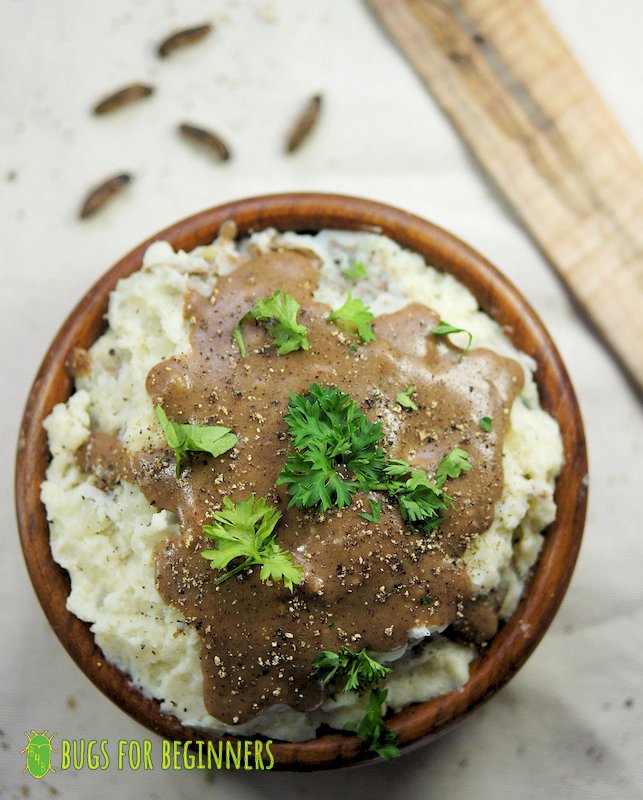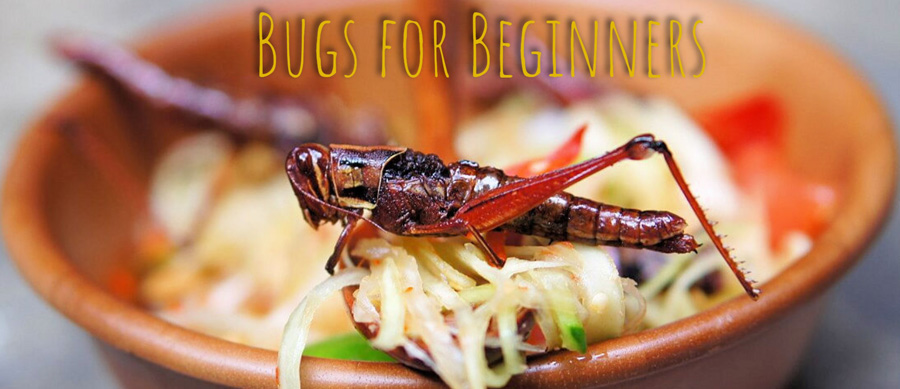Michela Dai Zovi won our very first contest giveaway a couple of months ago, a prize package from our friends at Entomo Farms which included cricket powder.
She has taken her winnings and turned them into recipes to share. Yesterday she shared with us Avacado Toast with Mealworms. Today’s delight: Mashed Potatoes and Cricket Gravy! That actually sounds really good right now for some reason…
Not only has she created these awesome recipes for you to try out, but she has also penned an introduction to each one…here’s today’s recipe. Thanks Mic!
Mashed Potatoes and Cricket Gravy
Serves 4
INTRO
For US Americans, a heaping steaming serving of mashed potatoes and gravy is an essential comfort food, especially around the chilly holiday season. I used to think that making good gravy was a time-consuming process, the last task at the end of an exhausting all-day turkey ordeal. But it turns out, like a great holiday dinner, and so many other things in life, gravy succeeds not because of any solitary factor but rather due to the combined efforts of its individual components. Warmth, fat, salt, and protein, all play their part–but it doesn’t need to be bird or beef protein; cricket will taste just as good. Mashed potatoes and cricket gravy will be a welcomed meal in any household trying to reduce their reliance on the products of factory farming. To make this dish dairy-free, butter can be replaced with the same amount of extra-virgin olive oil, and milk in the potatoes can be replaced with soy (but not almond) milk.
INGREDIENTS
Mashed Potatoes
5-6 high-starch potatoes, such as Russet
1⁄4-1⁄2 cup warm milk; dairy or soy
1⁄4 cup margarine or butter or 1/4 cup extra-virgin olive oil
2 garlic cloves, peeled and finely chopped (optional)
1⁄2 teaspoon baking powder
salt and pepper, to taste
Cricket Gravy
2 cups cricket broth (2 cups water, 3 tablespoons cricket powder)
1⁄4 cup butter or 1/4 cup extra-virgin olive oil
1⁄3 – 1/2 cup flour
1 teaspoon salt
1⁄2 teaspoon pepper
INSTRUCTIONS
1. Bring a pot of salted water to a boil. It is up to you if you want to peel your potatoes, or add texture and nutrients to your mashed potatoes by leaving the skin on. I rinse the potatoes and then peel them about halfway, lengthwise with a knife or peeler, leaving the skin on the hard-to-peel top and bottom of the potato, before roughly cubing into large, 2 inch (5 cm) cubes.
2. Add cubed potatoes to boiled water and cook for about 15 minutes until they are tender but firm; easy to pierce with a fork but not yet soggy. Drain potatoes and transfer back to pot. Let them sit in residual heat, with the pot covered but removed from the burner, for up to five minutes. This will further evaporate excess moisture, and make for fluffier mashed potatoes.
3. If you will be using oil instead of milk, consider aromatizing it by heating oil and garlic in a small skillet, and sauteing for about 3 minutes. Remove from heat. If you will not be replacing butter with oil, this step can be accomplished with 1/4 cup butter, or skipped entirely; it is purely optional, for the people who can’t seem to get enough garlic in their diet.
4. In a small saucepan, heat milk over low heat. If you are using butter, add to milk and heat until butter is melted, if it isn’t already. Using a potato masher, large fork, or electric mixer, slowly blend milk and butter mixture, or milk and heated oil, into potatoes until smooth and creamy. Whether you use milk and butter, or milk and oil, it’s important that the liquid you add is not cold–adding cold ingredients will cool down your potatoes and make them lumpy. Add oil slowly, if using instead of butter, until potatoes are desired consistency–don’t overdo it! Add baking powder and mix vigorously for 30-45 seconds. Season with salt and pepper to taste and set aside, covered to keep warm.
5. Make cricket broth by adding 3 tablespoons cricket powder to 2 cups boiling water; reduce heat and remove film, if any rises to top. Simmer on low heat, stirring occasionally.
6. Warm 1⁄4 cup butter or 1/4 cup extra-virgin olive oil over medium heat in a small pot. Add 1/3 cup flour slowly, whisking the entire time, to make a roux. Reserve remaining flour in case it is needed later, to thicken gravy. Continue until there are no lumps. Cook over medium heat for five minutes, stirring or whisking constantly.
7. Reduce heat to low and slowly add cricket broth, stirring broth before adding to gravy and then stirring gravy constantly, to ensure an integrated mixture. Cricket broth tends to resist fully dissolving, often keeping a cloudy consistency similar to miso soup, so it needs to be stirred often. Keep your distance from the gravy, as it may bubble and spit. Add salt and pepper, adjusting to taste. Increase heat to medium, and continue simmering for 2-5 minutes, stirring constantly, and adding remaining flour if necessary, until gravy has reached desired thickness.
7. Reheat mashed potatoes, if necessary, before transferring to large serving bowl. Transfer gravy to a serving container such as a gravy boat, and enjoy, pouring over each dollop of mashed potatoes as desired.
NOTE
Baking powder and baking soda are both chemical leaveners, which is why they’re included in almost all recipes for breads and pastries, to make them light and airy. They will work the same magic in mashed potatoes that they do in cakes, releasing CO2 and making them extra fluffy. If you use baking soda, you also need to have something acidic, like buttermilk or yogurt, but baking powder will work on its own.

Michela Dai Zovi is the driving force behind Bugs For Beginners, which is a forthcoming book for easing newbies into the fascinating, delicious, and nutritious, cuisine of edible insects. Visit her site:
















